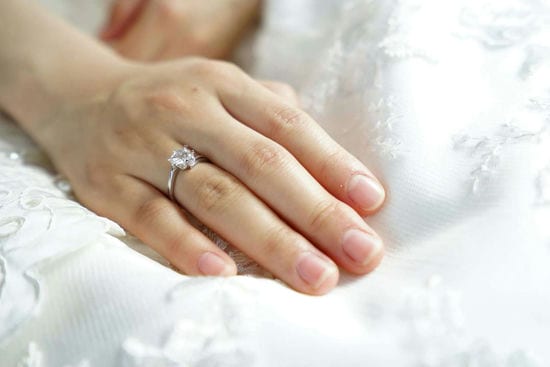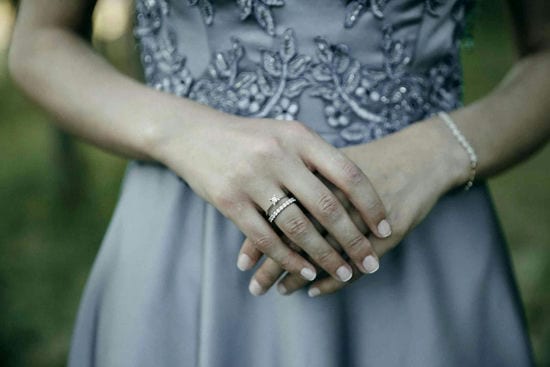Ever found yourself admiring someone's ring and wondering about the significance of its placement? It's a common curiosity, especially when considering the diverse customs surrounding ring-wearing traditions. So, let's delve into a question that often piques interest: Which finger is the ring finger? By exploring this query, we'll uncover the rich cultural tapestry and personal meanings that are woven into the practice of adorning this particular digit with symbols of love and commitment.

Have you ever wondered why we designate one finger as the "ring finger"? And what finger is the ring finger exactly or what hand is your ring finger? In fact, both of our two hands have one ring finger. It is the fourth digit of the human hand, counting from the thumb. It is situated between the middle finger and the pinky finger. This finger is called the "ring finger" because it is traditionally where wedding rings are worn in many cultures worldwide. Therefore, it's typically associated with the symbolism of love, commitment, and unity.
Throughout history, the ring finger has held special significance. It is believed by ancient Egyptians to have a direct vein leading to the heart. This ancient belief, known as the "Vena Amoris" or the "vein of love," has contributed to the choice of the ring finger for wearing wedding rings. For this reason, some expect to symbolically connect their heart to their partner by wearing a ring on the fourth finger. As a result, the ring finger has become the traditional placement for both wedding and engagement rings in many Western countries, including North America and much of Europe.
However, it's important to note that cultural variations exist, and in some Eastern European and Latin American countries, the right hand is preferred for wedding rings. These differences highlight the diversity of customs and beliefs surrounding the symbolism of the ring finger across the globe. To delve deeper into these fascinating customs, let's explore further.

Wedding ring traditions vary widely across different cultures and regions, including what finger does a ring go on. Let's explore some fascinating examples from around the world:
In countries like the UK, the US, and Canada, the tradition of wearing wedding rings on the left hand dates back centuries. This practice stems from medieval Europe, where rings were placed on the left hand during Christian betrothal ceremonies, symbolizing the connection to the heart.
One difference, however, is that British men historically didn't wear wedding rings until the 20th century. The practice changed during wartime when men wanted a reminder of their spouses while away. This tradition persists today in many Western countries.
Orthodox countries such as Bulgaria, Greece, and Ukraine follow the practice of wearing wedding rings on the fourth finger of the right hand. This tradition is deeply rooted in Orthodox Christianity as the Orthodox Christians believe that the right hand is associated with strength, power, and divine blessing. In their culture, the right hand has been symbolically linked to virtues such as righteousness and honor. Therefore, placing the wedding ring on the right hand's fourth finger is seen as a way to invoke these spiritual blessings upon the marriage.
Moreover, in Orthodox Christian theology, the number four holds symbolic significance. It represents completeness and wholeness, as seen in the four corners of the earth or the four seasons. By placing the wedding ring on the fourth finger of the right hand, Orthodox believers may be emphasizing the sacredness and completeness of the marital union.
Although Catholic countries like Brazil, and Argentina share the practice of wearing wedding rings on the right hand to Orthodox countries like Bulgaria, Greece, and Ukraine, the underlying reasons may differ slightly due to cultural and religious nuances.
In Catholicism, the right hand is often considered the hand of blessing, with significant religious gestures, such as making the sign of the cross, performed with the right hand. Therefore, wearing wedding rings on the right hand may symbolize invoking divine blessings upon the marriage.
Wedding rings aren't customary in Islamic weddings, but when used, they're typically worn on the left hand. Some Islamic cultures use rings as symbols of betrothal or engagement, with men wearing them on the right hand's fourth finger and women on the left hand's fourth finger.
In Islamic tradition, the right hand is associated with acts of righteousness, strength, and honor. Therefore, men should fulfill their commitment and responsibility within the marital union, aligning with the values associated with the right hand.
Conversely, the left hand is often regarded as the hand of protection and affection in many cultures. This may symbolize their role as nurturers and caregivers within the family unit, as well as the bond of love and affection between spouses.
This Islamic culture reflects a combination of cultural symbolism, religious values, and traditional gender roles within the context of marriage and commitment.
In countries like India, China, and Japan, wedding ring customs vary. In India, Hindu tradition dictates wearing the ring on the left hand's third finger, while in China, Western influence has led to rings being worn on the left hand's fourth finger. In Japan, rings are worn on the left hand, but some couples also exchange rings during the wedding ceremony to be worn on chains around their necks
In various African cultures, wedding ring traditions differ. For instance, in South Africa, Zulu culture sees wedding rings worn on the right hand, symbolizing unity and equality among couples. Similarly, in the northeast corner of Africa, Egypt also wears the wedding ring on the right hand. However, the reason why they chose the right hand is that the ancient Egyptian beliefs see the left hand as impure and negative. This perception likely stemmed from practical considerations, such as the left hand being used for hygiene purposes, as well as cultural and religious beliefs about the left side being inferior or unlucky.

Engagement rings have long found their place on the fourth finger of the left hand, symbolizing the journey toward commitment. After the knot-tying ceremony, the wedding ring is positioned first on the fourth finger of the left hand, with the engagement ring nestled snugly beside it. This tradition may symbolize marriage taking precedence over engagement in ceremony and commitment.
Yet, customs vary, with some cultures, like the Swiss, favoring the right hand for engagement rings and the left hand for wedding rings. This ring placement represents that both hands are decorated with charming and valuable gadgets.
Besides, in the past, women primarily adored engagement rings as a token of assurance. If the fiance gets cold feet before the wedding, the fiancee can get the basic compensation with this little ring. However, today's landscape sees a beautiful blend of traditions, with more same-sex couples proudly sporting these symbols of devotion. Whether it's about embracing the classic or crafting a unique narrative, the placement and stacking of the engagement ring ultimately reflect the bonds of love and commitment.
Traditionally, individuals wear a promise ring on the ring finger of their left hand if they're not married. Some may opt to transfer it to the right hand after marriage. However, how to wear a promise ring ultimately depends on personal preference.
A promise ring serves as a symbol of commitment, not necessarily implying an engagement or wedding. It can signify enduring friendship or faithfulness, especially where same-sex unions face legal constraints.
It can be traced back to medieval Europe, particularly England and France, where lovers exchanged "posy rings" inscribed with love poems. They hold significance as tangible expressions of devotion and loyalty, particularly in cultures where formal unions face legal or societal challenges. While there's no strict rule for placement, wearing a promise ring on the designated "engagement or wedding ring finger" often adds sentimental value, emphasizing the promise's gravity and sincerity.
As we have seen, ring placement on specific fingers, whether for weddings, engagements, or promises, is deeply ingrained in cultural symbolism and personal meaning. It highlights the rich tapestry of traditions and customs that shape our relationships and celebrations. Regardless of which finger is the ring finger or where the ring rests, it's the love, commitment, and bond shared between partners that hold the utmost importance.
If you are not married, there are no set rules or traditions regarding which finger you should wear rings on. In such cases, you can wear the ring on any finger if you like, boiling the matter down to personal preference.
In some cultures and traditions, wearing a wedding ring on the right hand is customary. For example, in Orthodox Christian countries like Bulgaria, Greece, and countries like Ukraine, Brazil, and Argentina, influenced by Catholicism, it's common to wear wedding rings on the right hand.
Wearing a ring on the middle finger is less common, as it's typically associated with power, balance, and stability. Since it's often the largest finger, rings are noticeable, and they can also be prone to catching and damage due to their size. These factors may contribute to the fact that wearing rings on the middle finger is not mainstream.
Learn how to clean moissanite jewelry effectively with our expert tips. Keep your moissanite sparkling with proper care and maintenance techniques.
Read MoreLearn how to clean rusted jewelry effectively. Discover what causes jewelry to rust and tips to prevent rust, ensuring your items stay pristine and beautiful.
Read MoreLearn how to make paper earrings with our step-by-step guide. Perfect for DIY jewelry enthusiasts, here is all you need to create beautiful paper earrings.
Read MoreLearn how to fix a broken earring with our quick and easy repair guide. Discover simple steps to restore your favorite earrings and keep them looking beautiful.
Read More